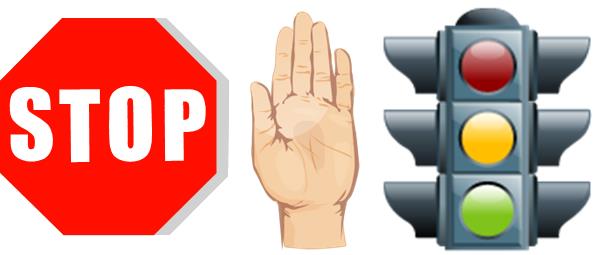SATIETY 101: Recognizing Satiety

As mentioned in Satiated vs Stuffed, satiety is not quite the same as being full. Full means your upper stomach has reached its maximum capacity: that you have overeaten again – an old habit that made you obese enough to qualify for weight loss surgery. Satiety happens on your way to being full. With a properly adjusted band, you will be comfortable if you stop eating when you're satiated, but you’ll experience discomfort if you eat until you're full.
This third article in the Satiety 101 series discusses the signals your body gives to tell you you’re satiated, but that’s only half the battle. The other half involves heeding instead of ignoring those signals. That subject could fill a book (which that I might write some day). Today we’ll focus on recognizing your own unique Stop Eating Signals.
Because of its anatomical position (near your diaphragm, and pressing on the vagus nerve at the top of your stomach), the band’s presence (but not your band itself – which we must remember is an inert piece of plastic without any magic at all inside) can give you quick feedback about your eating behavior. The feedback is written in a language issued and understood by your brain, with assistance from your endocrine and digestive systems. Even if you were lousy in your high school French class, you will have to learn how to get directions in that language, so you won’t end up on Weight Gain Road instead op Weight Loss Avenue. Those directions come in the form of what I call Soft Stop and Hard Stop signals.
To understand those directions, you’ll need to slow down and pay attention while you eat. It takes 15 to 20 minutes for satiety signals to reach your brain and to be broadcast to the rest of you. If you usually eat with a crowd (family, friends, coworkers), you might need to try eating by yourself for a few meals so you won't be distracted. Stop signals can be subtle and they can come from unexpected parts of your body. It's better to heed a gentle reminder than wait for a hammer to hit you on the head.
SOFT STOPS are your early warning system, gentle reminders from your body that it's time to stop eating. Because they don't hurt much, they're easy to ignore. They include:
· Mild queasiness (an icky, but not about-to-vomit, feeling)
· Fullness or pressure in the back of the throat
· Pressure in the chest or just below the breastbone
· Throat clearing
· Some difficulty swallowing
· Burping (or the urge to burp)
· Taking a deep breath
· Mild coughing
· A sigh
· Hiccups
· Watering eyes
· Runny nose
· Left shoulder pain
· A sneeze
· More saliva in the mouth than usual
· A sudden distaste for the food you were enjoying a moment before
As soon as you notice one of these signs, stop eating! I don't care if your stubborn mind is insisting that it's okay to continue (because it thinks you have room for just one more bite, or the food tastes good, or you haven't cleaned your plate, or you deserve the food, or whatever's going on in there). If you go on eating past this point, you won't be changing your eating behavior and you're likely to get into trouble…that is, a hard stop.
HARD STOPS are the equivalent of running into a brick wall. They can happen without any apparent warning, but usually you have sped heedlessly past a soft stop before you hit the wall. Hard stops are the painful and sometimes embarrassing reminders that you have eaten too much, too fast, in bites that were too big, without chewing enough. They include:
· Chest pain and/or painful pressure or tightness in the chest
· Feeling like you have a rock in the back of your throat
· A burning sensation in the throat
· A “stuck” feeling, as if the food you’ve eaten has nowhere to go
· Productive burps (PB's) – regurgitation of food, kind of like the way a baby erps up milk
· Sliming (excess saliva and mucus that's so profuse, you have to spit it out)
When you experience a hard stop, STOP EATING! It's not at all a good idea to keep eating after you experience a hard stop, even if the discomfort goes away and your plate of food still looks appealing. You may feel fine and may in fact be able to eat some more, but you should not eat more. The hard stop has irritated your upper gastrointestinal system. Continuing to eat will just perpetuate the problem, getting you into a never-ending cycle of eat-hard stop-pain-eat-hard stop-pain. Cycles like that tend to turn into complications like band slips and esophageal and stomach dilation. That’s the reason for my next piece of advice: follow a liquid diet for 24 hours after a hard stop episode, then transition carefully back to pureed then soft then solid food.
If you’re like me, you did not have WLS in order to live on liquids for the rest of your life. That’s yet another reason to learn how to prevent hard stops in the first place, so that you can eat and enjoy real food at every meal.
Now here’s one last chunk of information before the bell rings and today’s class ends. You may not experience any or all of these stop signals any or all of the time. At breakfast you might get one signal and at lunch, an entirely different one. At dinner, you may notice no stop signal at all. As time goes on and you lose weight and the amount of saline in your band changes, your stop signals may change as well.
All that can be frustrating, but it will force you to go on eating slowly and carefully for the rest of your life, and that’s actually a good practice for anyone, banded or not. That plate of food before you is a blessing that some people in this world can only dream of. Those small portions may look puny to you, but would be a feast to someone else. So treat your food, and your body, with the care they deserve.
Learning to recognize satiety over and over again is an ongoing process because our bodies are not statues made of marble. We are all marvelous, unique, and complex creatures who change by the minute, every day of our lives. Click here to read about how those changes can affect soft and hard stop signals. http://www.bariatricpal.com/page/articles.html/_/support/post-op-support/restriction-riddles-r93
This is the third and final article in the Satiety 101 series of articles.



HealthyNewMe 1,935
Posted
You will never know how much I appreciated reading and learning from your last three posts..... Thank you, Jean.
Share this comment
Link to comment
Share on other sites